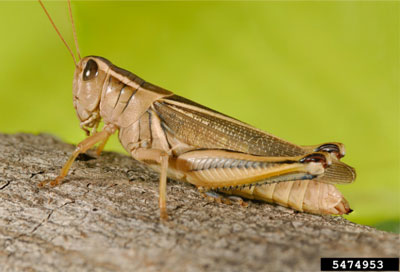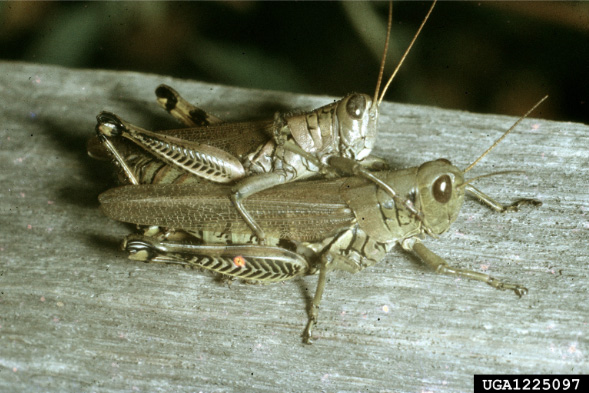Grasshoppers in the Yard and Garden

Figure 1: Two-striped grasshopper, Melanoplus bivittatus. Photo by J. Berger, Bugwood.org. Larger image (119K)
Grasshoppers are becoming an issue around the state. Once grasshoppers are adults and have entered the yard and garden, management is extremely challenging. Consider focusing on the most vulnerable trees and plants for management (and those of importance). Management options are available, but several applications might be necessary (following the label).
Life Cycle
- Most grasshoppers overwinter in the egg stage in the soil.
- After egg hatch in mid-to-late spring, the nymphs (immatures) immediately begin feeding.
- There are at least five or six stages of nymphs before the grasshoppers reach adulthood.
- The adult grasshoppers can live for several months into late summer/early fall.
Management
- Many plants and flowers will be hard to protect.
- Screen garden and sensitive areas with metal window-type screening, as they easily chew through fabric.
- Be prepared early next year for possible grasshopper issues.
- Several insecticides are available and labeled for use on grasshoppers.

Figure 2: Differential grasshopper, Melanoplus differentialis. Photo by E. Manigault, Clemson University.
Organic Insecticides and Biological Controls
- Neem oil (products such as AzaGuard).
- Pyrethrins (products such as PyGanic).
- Nosema locustae (brands such as NoLo Bait).
- Nosema locustae is a protozoan/fungus that is selective to grasshoppers and applied with a bran that the grasshoppers have to consume. Only effective when grasshoppers are in their 1st and 2nd nymph stages (when the grasshoppers are 1/4-1/2” long).
Non-Organic Insecticides
- Bifenthrin & zeta-cypermethrin (products such as Ortho Home Defense Insect Killer for Lawn and Landscape and Ortho Bug B Gon Insect Killer for Lawns and Gardens).
- Cyfluthrin (products such as Bioadvanced Complete Insect Killer).
- Carbaryl (Eco Bran bait or Sevin).
Further Information
See the Colorado State University Extension webpage for Grasshopper Control in Gardens and Small Acreages.
To learn more about the topics discussed on this page, contact the Schutter Diagnostic Lab. If you suspect an infestation on your property, contact your local extension agent, the Schutter Diagnostic Lab at Montana State University, or the Montana Department of Agriculture.
This June 2021 fact sheet is also available as aprintable PDF (15.7MB)
Disclaimer: These recommendations are provided only as a guide. It is always the pesticide applicator’s responsibility, by law, to read and follow all current label directions for the specific pesticide being used. If any information in these recommendations disagrees with the label, the recommendation must be disregarded. No endorsement is intended for products mentioned. The authors and Montana State University assume no liability resulting from the use of these recommendations. The Montana State University Extension Service is an ADA/EO/AA/Veteran’s Preference Employer and Provider of Educational Outreach.
